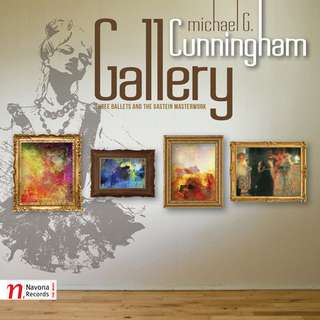|
Back
02/02/2013
“Gallery”
Michael G. Cunningham: Nyadina [1] – She, opus 250 [2] – Chrysalys at Mardi Gras, opus 259 [3] – The Gastein Masterwork, opus 256 [4]
Prague Radio Orchestra, Robert Ian Winstin (conductor) [1], Moravian Philharmonic Orchestra, Petr Vronský (conductor) [2, 4], St. Petersburg State Symphony Orchestra, Vladimir Lande (conductor) [3]
Recorded in Prague (October 2008) [1], Olomouc (March 2011 [2], September 2010 & September 2011 [4]) and in St. Petersburg (February 2012) [3] – 70'
Navona Records NV5893

   
This CD, titled “Gallery”, contains four works by US composer Michael G. Cunningham and shows him to have a deft facility for an eclectic array of styles.
Cunningham (born in 1937) teaches music at the University of Wisconsin, Eau Claire, and is the author of several books on music. His own compositions number more than 250 and include a large number of songs.
Three of the pieces on the CD are ballets. I cannot find out if they have any performance history or were commissioned by anyone intending to choreograph them. Information on the CD case simply gives details of the recording sessions. However this is an enhanced CD: the disc can be inserted into a computer and one can peruse the full scores and read a few frustratingly brief notes basically recounting the plot of each ballet.
Nyadina is a singular oddity in being the only case I have ever come across of a composer writing a core to accompany a ballet that already exists. The ballet in question (by George Balanchine, no less) is known as The Water Nymph Ballet and appears in the 1938 film The Goldwyn Follies (which can be found, recently restored, on DVD). George Gershwin had been hired to compose for the film, but he died while it was being made. The film contains a few of his songs, but the music for this ballet is a rather routine slice of “movie music” (Vernon Duke and/or Alfred Newman seem to have devised it). Cunningham’s music is much more interesting than what is in the film but I can’t imagine anyone wanting to restage the ballet as it was designed for performance in a film studio where the ballerina (Tamara Geva) rises, dripping wet, from a pool of water. She quickly and mysteriously dries off and cavorts about a neo-classical set with a corps clad in glittery tutus. She then returns to her pond. It’s all very Hollywood and quite, quite mad.
Cunningham’s piece, 10 minutes in length, is a genial, lively conjuring up of the dance band music of the era. It sounds like it would be eminently choreographable (if that’s a word) by someone wanting to stage a tribute to Fred Astaire and Ginger Rogers. It was recorded in October, 2008, in Prague, performed by the Prague Radio Orchestra under Robert Ian Winstin.
The second ballet score is She, for a scenario based on Rider Haggard’s 1886 novel telling of an alluring woman ruling a remote kingdom who turns out to be 500 years old. (Lost Horizon and The Makropulos Case have similar plot elements.) The score, in three sections lasting about 13 minutes, has an echo of Prokofiev. As with Nyadina, it has the potential for inspiring a choreographer, whether using the She scenario or not.
The third ballet is Chrysalis at Mardi Gras with a scenario derived from a story that combines elements of the Cinderella tale plus that of the ugly duckling becoming a swan. Just under 12 minutes long, it is distinctly different from the previous two scores; wind instruments are prominent and it evokes a hectic mardi gras.
While the three ballet pieces are agreeably interesting, the fourth work, The Gastein Masterwork, is an absolute delight. Much of the credit is due to its source, Franz Schubert’s Sonata in D, D 850. In the tangled mass of papers Schubert left is reference to a symphony he worked on while staying at the Austrian resort of Bad Gastein. Cunningham surmises that the working notes for the symphony ended up as the piano sonata. Its sonata form (not restricted to the type of composition that has come down to us as the solo sonata) is also eminently applicable to symphonic orchestration. Cunningham’s orchestration is full of sparkle and fun, just like the best of Schubert. Just as Arnold Schoenberg gave us a “new” Brahms symphony when he orchestrated the Piano Quartet No. 1, Michael G. Cunningham has given us a “new” Schubert symphony. And just as the Brahms/Schoenberg work has a place in the orchestral repertory, this deserves to be widely performed as well.
As noted above, the works on this disk were recorded over a four-year period at five different sessions in three cities in Eastern Europe where, I assume, low costs don’t rule out a decent professional level of performing and recording skill - which is exactly what has been achieved. This CD acts as a calling card for these engaging works and it would be great if it led to live performances.
Michael Johnson
|